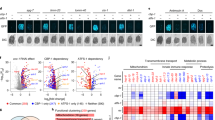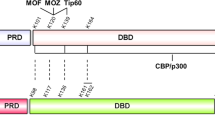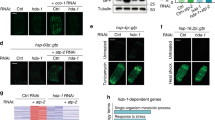Abstract
Cellular damage invoked by reactive oxygen species plays a key role in the pathobiology of cancer and aging. Forkhead box class O (FoxO) transcription factors are involved in various cellular processes including cell cycle regulation, apoptosis and resistance to reactive oxygen species, and studies in animal models have shown that these transcription factors are of vital importance in tumor suppression, stem cell maintenance and lifespan extension. Here we report that the activity of FoxO in human cells is directly regulated by the cellular redox state through a unique mechanism in signal transduction. We show that reactive oxygen species induce the formation of cysteine-thiol disulfide–dependent complexes of FoxO and the p300/CBP acetyltransferase, and that modulation of FoxO biological activity by p300/CBP-mediated acetylation is fully dependent on the formation of this redox-dependent complex. These findings directly link cellular redox status to the activity of the longevity protein FoxO.
This is a preview of subscription content, access via your institution
Access options
Subscribe to this journal
Receive 12 print issues and online access
$259.00 per year
only $21.58 per issue
Buy this article
- Purchase on Springer Link
- Instant access to full article PDF
Prices may be subject to local taxes which are calculated during checkout






Similar content being viewed by others
References
Davies, K.J. Protein damage and degradation by oxygen radicals. I. General aspects. J. Biol. Chem. 262, 9895–9901 (1987).
Barnham, K.J., Masters, C.L. & Bush, A.I. Neurodegenerative diseases and oxidative stress. Nat. Rev. Drug Discov. 3, 205–214 (2004).
Hussain, S.P., Hofseth, L.J. & Harris, C.C. Radical causes of cancer. Nat. Rev. Cancer 3, 276–285 (2003).
Balaban, R.S., Nemoto, S. & Finkel, T. Mitochondria, oxidants, and aging. Cell 120, 483–495 (2005).
Accili, D. & Arden, K.C. FoxOs at the crossroads of cellular metabolism, differentiation, and transformation. Cell 117, 421–426 (2004).
Greer, E.L. & Brunet, A. FOXO transcription factors at the interface between longevity and tumor suppression. Oncogene 24, 7410–7425 (2005).
Paik, J.H. et al. FoxOs are lineage-restricted redundant tumor suppressors and regulate endothelial cell homeostasis. Cell 128, 309–323 (2007).
Tothova, Z. et al. FoxOs are critical mediators of hematopoietic stem cell resistance to physiologic oxidative stress. Cell 128, 325–339 (2007).
Hwangbo, D.S., Gershman, B., Tu, M.P., Palmer, M. & Tatar, M. Drosophila dFOXO controls lifespan and regulates insulin signalling in brain and fat body. Nature 429, 562–566 (2004).
Kenyon, C., Chang, J., Gensch, E., Rudner, A. & Tabtiang, R.A. C. elegans mutant that lives twice as long as wild type. Nature 366, 461–464 (1993).
Zhang, Y. & Chen, F. Reactive oxygen species (ROS), troublemakers between nuclear factor-kappaB (NF-kappaB) and c-Jun NH(2)-terminal kinase (JNK). Cancer Res. 64, 1902–1905 (2004).
D'Autréaux, B. & Toledano, M.B. ROS as signalling molecules: mechanisms that generate specificity in ROS homeostasis. Nat. Rev. Mol. Cell Biol. 8, 813–824 (2007).
Brennan, J.P. et al. Detection and mapping of widespread intermolecular protein disulfide formation during cardiac oxidative stress using proteomics with diagonal electrophoresis. J. Biol. Chem. 279, 41352–41360 (2004).
Lee, S.R. et al. Reversible inactivation of the tumor suppressor PTEN by H2O2. J. Biol. Chem. 277, 20336–20342 (2002).
Bossis, G. & Melchior, F. Regulation of SUMOylation by reversible oxidation of SUMO conjugating enzymes. Mol. Cell 21, 349–357 (2006).
Nadeau, P.J., Charette, S.J., Toledano, M.B. & Landry, J. Disulfide Bond-mediated multimerization of Ask1 and its reduction by thioredoxin-1 regulate H(2)O(2)-induced c-Jun NH(2)-terminal kinase activation and apoptosis. Mol. Biol. Cell 18, 3903–3913 (2007).
Burgoyne, J.R. et al. Cysteine redox sensor in PKGIa enables oxidant-induced activation. Science 317, 1393–1397 (2007).
Brunet, A. et al. Stress-dependent regulation of FOXO transcription factors by the SIRT1 deacetylase. Science 303, 2011–2015 (2004).
Essers, M.A. et al. FOXO transcription factor activation by oxidative stress mediated by the small GTPase Ral and JNK. EMBO J. 23, 4802–4812 (2004).
Nemoto, S. & Finkel, T. Redox regulation of forkhead proteins through a p66shc-dependent signaling pathway. Science 295, 2450–2452 (2002).
van der Horst, A. et al. FOXO4 transcriptional activity is regulated by monoubiquitination and USP7/HAUSP. Nat. Cell Biol. 8, 1064–1073 (2006).
van der Horst, A. et al. FOXO4 is acetylated upon peroxide stress and deacetylated by the longevity protein hSir2(SIRT1). J. Biol. Chem. 279, 28873–28879 (2004).
Brenkman, A.B. et al. The peptidyl-isomerase Pin1 regulates p27kip1 expression through inhibition of Forkhead box O tumor suppressors. Cancer Res. 68, 7597–7605 (2008).
Mahmud, D.L. et al. Phosphorylation of forkhead transcription factors by erythropoietin and stem cell factor prevents acetylation and their interaction with coactivator p300 in erythroid progenitor cells. Oncogene 21, 1556–1562 (2002).
Matsuzaki, H. et al. Acetylation of Foxo1 alters its DNA-binding ability and sensitivity to phosphorylation. Proc. Natl. Acad. Sci. USA 102, 11278–11283 (2005).
Obsilova, V. et al. 14–3-3 Protein interacts with nuclear localization sequence of forkhead transcription factor FoxO4. Biochemistry 44, 11608–11617 (2005).
Jelluma, N. et al. Glucose withdrawal induces oxidative stress followed by apoptosis in glioblastoma cells but not in normal human astrocytes. Mol. Cancer Res. 4, 319–330 (2006).
Nishiyama, A. et al. Identification of thioredoxin-binding protein-2/vitamin D(3) up-regulated protein 1 as a negative regulator of thioredoxin function and expression. J. Biol. Chem. 274, 21645–21650 (1999).
Kasper, L.H. et al. Two transactivation mechanisms cooperate for the bulk of HIF-1-responsive gene expression. EMBO J. 24, 3846–3858 (2005).
Alvarez, B., Martinez, A.C., Burgering, B.M. & Carrera, A.C. Forkhead transcription factors contribute to execution of the mitotic programme in mammals. Nature 413, 744–747 (2001).
Medema, R.H., Kops, G.J., Bos, J.L. & Burgering, B.M. AFX-like Forkhead transcription factors mediate cell-cycle regulation by Ras and PKB through p27kip1. Nature 404, 782–787 (2000).
Lill, N.L., Grossman, S.R., Ginsberg, D., DeCaprio, J. & Livingston, D.M. Binding and modulation of p53 by p300/CBP coactivators. Nature 387, 823–827 (1997).
Major, M.L., Lepe, R. & Costa, R.H. Forkhead box M1B transcriptional activity requires binding of Cdk-cyclin complexes for phosphorylation-dependent recruitment of p300/CBP coactivators. Mol. Cell. Biol. 24, 2649–2661 (2004).
Brent, M.M., Anand, R. & Marmorstein, R. Structural basis for DNA recognition by FoxO1 and its regulation by posttranslational modification. Structure 16, 1407–1416 (2008).
Tsai, K.L. et al. Crystal structure of the human FOXO3a-DBD/DNA complex suggests the effects of post-translational modification. Nucleic Acids Res. 35, 6984–6994 (2007).
Motta, M.C. et al. Mammalian SIRT1 represses forkhead transcription factors. Cell 116, 551–563 (2004).
Emerling, B.M., Weinberg, F., Liu, J.L., Mak, T.W. & Chandel, N.S. PTEN regulates p300-dependent hypoxia-inducible factor 1 transcriptional activity through Forkhead transcription factor 3a (FOXO3a). Proc. Natl. Acad. Sci. USA 105, 2622–2627 (2008).
Giannakou, M.E. & Partridge, L. The interaction between FOXO and SIRT1: tipping the balance towards survival. Trends Cell Biol. 14, 408–412 (2004).
Bjelakovic, G., Nikolova, D., Gluud, L.L., Simonetti, R.G. & Gluud, C. Mortality in randomized trials of antioxidant supplements for primary and secondary prevention: systematic review and meta-analysis. J. Am. Med. Assoc. 297, 842–857 (2007).
Bjelakovic, G., Nikolova, D., Simonetti, R.G. & Gluud, C. Antioxidant supplements for preventing gastrointestinal cancers. Cochrane Database Syst. Rev. CD004183 (2004).
Schulz, T.J. et al. Glucose restriction extends Caenorhabditis elegans life span by inducing mitochondrial respiration and increasing oxidative stress. Cell Metab. 6, 280–293 (2007).
Nishinaka, Y. et al. Importin alpha1 (Rch1) mediates nuclear translocation of thioredoxin-binding protein-2/vitamin D(3)-up-regulated protein 1. J. Biol. Chem. 279, 37559–37565 (2004).
Chenna, R. et al. Multiple sequence alignment with the Clustal series of programs. Nucleic Acids Res. 31, 3497–3500 (2003).
Yang, Y.H. et al. Normalization for cDNA microarray data: a robust composite method addressing single and multiple slide systematic variation. Nucleic Acids Res. 30, e15 (2002).
Acknowledgements
We thank G.J.P.L. Kops and M.B. Toledano for critically reading the manuscript, M. Putker and I. van Zutphen for experimental support, E. Kalkhoven (University Medical Center Utrecht) for reagents and our colleagues for discussions and suggestions. This work was supported by grants from The Netherlands Science Organization (NWO, Vici), KWF (Dutch Cancer Foundation), the Center for Biomedical Genetics (CBG) and the Cancer Genomics Center (CGC).
Author information
Authors and Affiliations
Contributions
T.B.D. and B.M.T.B. designed most experiments. T.B.D., L.M.M.S., M.H.v.T., P.L.J.d.K., D.v.L., M.G.K., A.S., A.M. and B.M.T.B. performed the experiments and analyzed the data. A.B.B., F.C.P.H. and J.Y. provided essential reagents. T.B.D. and B.M.T.B. wrote the paper.
Corresponding authors
Supplementary information
Supplementary Text and Figures
Supplementary Figures 1–12, Supplementary Table 1 and Supplementary Methods (PDF 5730 kb)
Rights and permissions
About this article
Cite this article
Dansen, T., Smits, L., van Triest, M. et al. Redox-sensitive cysteines bridge p300/CBP-mediated acetylation and FoxO4 activity. Nat Chem Biol 5, 664–672 (2009). https://doi.org/10.1038/nchembio.194
Received:
Accepted:
Published:
Issue Date:
DOI: https://doi.org/10.1038/nchembio.194
This article is cited by
-
FOXO transcription factors as mediators of stress adaptation
Nature Reviews Molecular Cell Biology (2024)
-
PAX3-FOXO1 uses its activation domain to recruit CBP/P300 and shape RNA Pol2 cluster distribution
Nature Communications (2023)
-
Reaction-based fluorogenic probes for detecting protein cysteine oxidation in living cells
Nature Communications (2022)
-
The FOXO family of transcription factors: key molecular players in gastric cancer
Journal of Molecular Medicine (2022)
-
IRC-Fuse: improved and robust prediction of redox-sensitive cysteine by fusing of multiple feature representations
Journal of Computer-Aided Molecular Design (2021)



